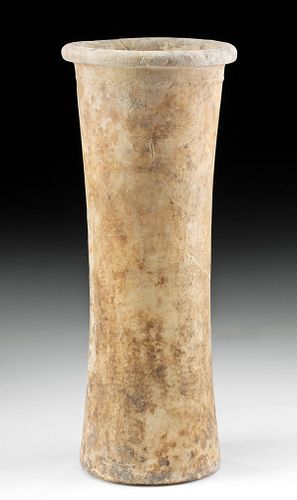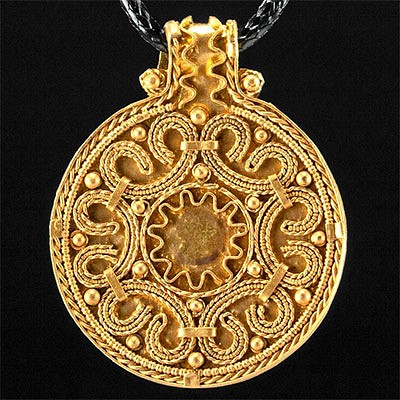Tall Egyptian Early Dynastic Alabaster Vase
Lot 2
About Seller
Artemis Gallery
686 S Taylor Ave, Ste 106
Louisville, CO 80027
United States
Selling antiquities, ancient and ethnographic art online since 1993, Artemis Gallery specializes in Classical Antiquities (Egyptian, Greek, Roman, Near Eastern), Asian, Pre-Columbian, African / Tribal / Oceanographic art. Our extensive inventory includes pottery, stone, metal, wood, glass and textil...Read more
Categories
Estimate:
$2,500 - $3,500
Absentee vs Live bid
Two ways to bid:
- Leave a max absentee bid and the platform will bid on your behalf up to your maximum bid during the live auction.
- Bid live during the auction and your bids will be submitted real-time to the auctioneer.
Bid Increments
| Price | Bid Increment |
|---|---|
| $0 | $25 |
| $300 | $50 |
| $1,000 | $100 |
| $2,000 | $250 |
| $5,000 | $500 |
| $10,000 | $1,000 |
| $20,000 | $2,500 |
| $50,000 | $5,000 |
| $100,000 | $10,000 |
| $200,000 | $20,000 |
About Auction
By Artemis Gallery
Aug 19, 2021
Set Reminder
2021-08-19 10:00:00
2021-08-19 10:00:00
America/New_York
Bidsquare
Bidsquare : Ancient & Ethnographic Art Through The Ages
https://www.bidsquare.com/auctions/artemis-gallery/ancient-ethnographic-art-through-the-ages-7345
Ancient art from Egypt, Greece, Italy and the Near East, as well as Asian, Fossils, Pre-Columbian, Native American, African / Tribal / Oceanic, Fine art, and much more! All categories, all price ranges... all legally acquired and guaranteed to be as described or your money back. Artemis Gallery info@artemisgallery.com
Ancient art from Egypt, Greece, Italy and the Near East, as well as Asian, Fossils, Pre-Columbian, Native American, African / Tribal / Oceanic, Fine art, and much more! All categories, all price ranges... all legally acquired and guaranteed to be as described or your money back. Artemis Gallery info@artemisgallery.com
- Lot Description
Ancient Egypt, Early Dynastic Period, 1st to 2nd Dynasty, ca. 3100 to 2686 BCE. A gorgeous vase of a slender form that is hand-carved from translucent, honey-yellow alabaster with darker, opaque veining visible within the stone matrix. The cylindrical vessel features a planar base, a gently corseted body, and a lightly flared shoulder accentuated with a segmented, cord-patterned ring in relief, all beneath a thick, annular rim. The deep interior cavity was drilled out using a series of progressively finer drill bits and copious amounts of abrasive sand, and evidence of the ancient drilling is still visible along the bottom surfaces. Size: 3.375" W x 8.4" H (8.6 cm x 21.3 cm)
The Egyptians were master carvers and used the abundant stone deposits in the Nile Valley and the Eastern Sahara throughout their history to fashion sculptures, vessels, and monumental buildings. The perfect symmetry of this example demonstrates their skill. Alabaster vessels were often personal items and were frequently buried with their owners.
Cf. The Metropolitan Museum of Art, accession numbers 01.4.86 and 12.181.109
Provenance: private Corpus Christi, Texas, USA estate collection, acquired 1960s to 1970s
All items legal to buy/sell under U.S. Statute covering cultural patrimony Code 2600, CHAPTER 14, and are guaranteed to be as described or your money back.
A Certificate of Authenticity will accompany all winning bids.
PLEASE NOTE: Due to recent increases of shipments being seized by Australian & German customs (even for items with pre-UNESCO provenance), we will no longer ship most antiquities and ancient Chinese art to Australia & Germany. For categories of items that are acceptable to ship to Australia or Germany, please contact us directly or work with your local customs brokerage firm.
Display stands not described as included/custom in the item description are for photography purposes only and will not be included with the item upon shipping.
#165117Repair to large area of rim and upper shoulder from multiple pieces, with a couple of stable hairline fissures stemming from broken areas, and small chips and light adhesive residue along break lines. Abrasions and encrustations to most interior and exterior surfaces. Nice translucency to stone color when light is shined inside interior. Old inventory labels on base.Condition
- Shipping Info
-
All shipping is handled in-house for your convenience. Your invoice from Artemis Gallery will include shipping calculation instructions. If in doubt, please inquire BEFORE bidding for estimated shipping costs for individual items.
-
- Buyer's Premium



 EUR
EUR CAD
CAD AUD
AUD GBP
GBP MXN
MXN HKD
HKD CNY
CNY MYR
MYR SEK
SEK SGD
SGD CHF
CHF THB
THB














